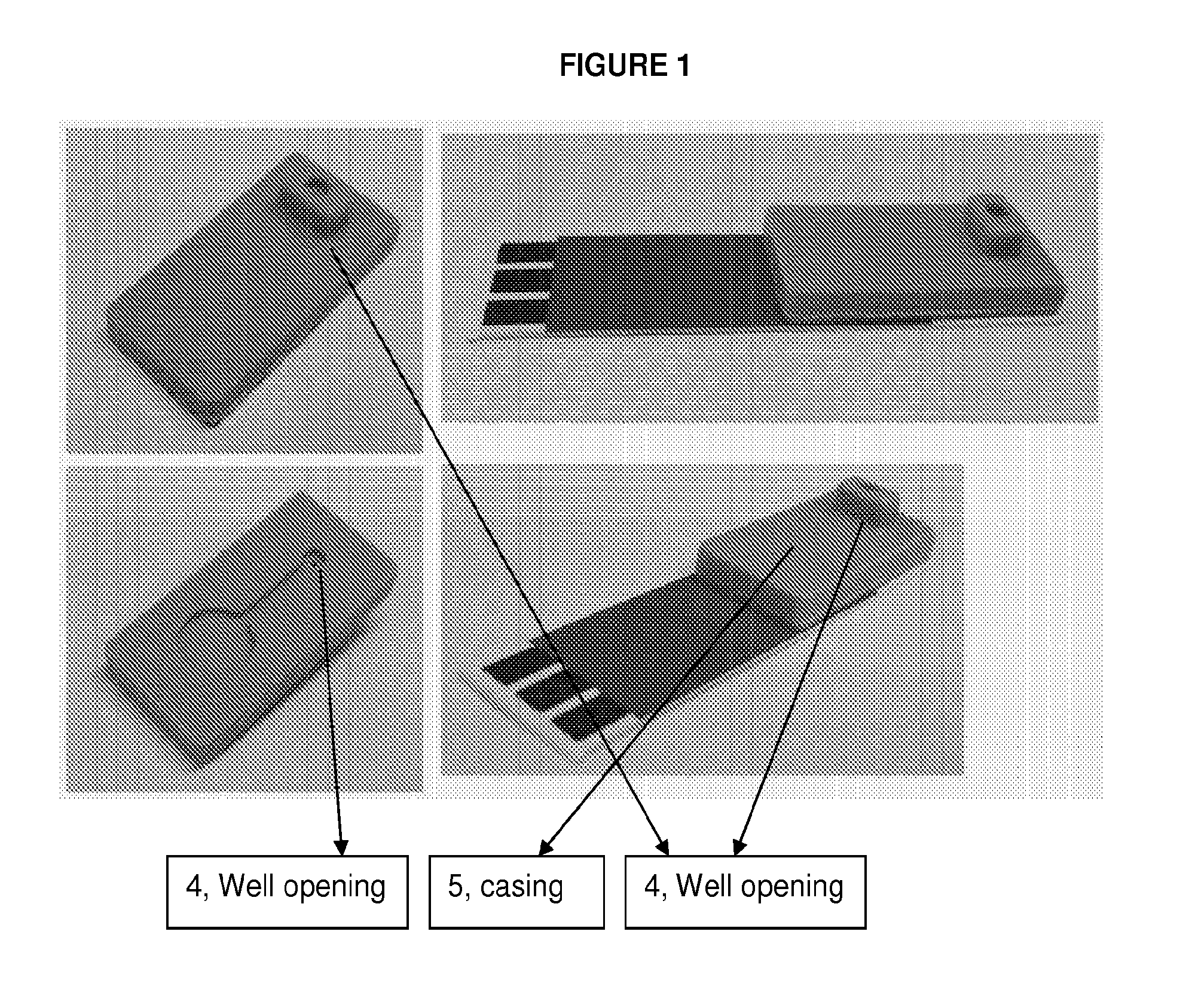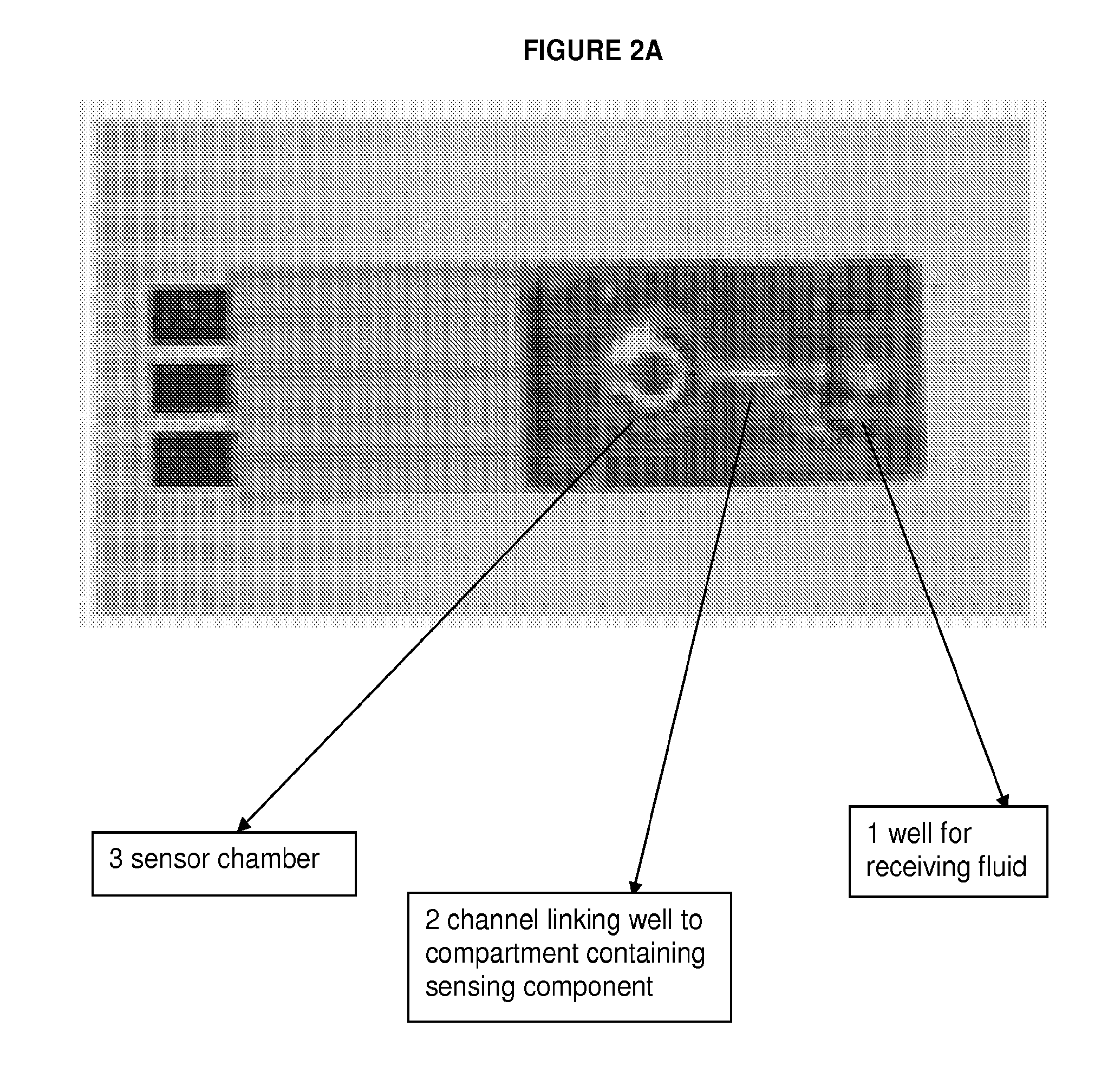Integrated device for surface-contact sampling, extraction and electrochemical measurements
a surface contact and electrochemical technology, applied in the field of non-invasive collection and monitoring of analytes, can solve problems such as controversy
- Summary
- Abstract
- Description
- Claims
- Application Information
AI Technical Summary
Benefits of technology
Problems solved by technology
Method used
Image
Examples
example 1
Initial Design
[0061]FIG. 3A and FIG. 3B show the design of the new integrated fluidics design for sampling and testing tear analytes. It consists of a single silicone piece which is fixed to a screen print's surface. It has the advantage that the single silicone piece can store fluid that is collected in the raised sampling portion. Compressing that raised sampling portion pushes the fluid up to sampling film for extraction. Once the compression is released, the liquid is drawn back to sensor for detection
[0062]Dry reagents could conceivably be stored in channel for long term storage.
[0063]Extracting fluids could conceivably be contained using a simple fluidics valve which allows said fluid to be contained with decreased evaporation until time of use.
[0064]The device was designed using the molding shown in FIG. 4A and FIG. 4B.
[0065]The operation of the device is shown by reference to the prototype produced in clear plastic and shown in FIG. 5. In this FIG. 5A there is shown the prot...
example 2
Design and Concept Testing of Disposable Tear Glucose Biosensor
[0071]As discussed herein above, monitoring tear glucose levels has potential as an approach for the non-invasive estimation of blood glucose. The present Example provides details of the production of a device that meets the needs of a tear glucose biosensor.
[0072]To briefly summarize the present example, three approaches for chronoamperometric glucose sensing were evaluated including glucose oxidase mediated by potassium ferricyanide or oxygen with hydrogen peroxide catalyst, Prussian Blue, and potassium ferricyanide mediated glucose dehydrogenase. For tear sampling, calcium alginate, poly(2-hydroxyethyl methacrylate), and polyurethane foam were screened as an absorbent tear sampling material. A quantitative model based on the proposed function of concept device was created.
[0073]For glucose sensing, it was found that potassium ferricyanide with glucose dehydrogenase was ideal, featuring oxygen insensitivity, long-term ...
example 3
System Integration and Model Validation of Disposable Tear Glucose Biosensor
[0104]Example 2 shows the design and testing of a new disposable tear glucose biosensor. The validation of the biosensor is further described herein. The biosensor includes an integrated fluidics portion of the prototype. The present Example shows the design, casting, and testing of the same. A sensor was created using screen printed sensors integrated with a silicone rubber fluidics system and absorbent polyurethane foam. A simulated eye surface was prepared using fluid saturated poly(2-hydroxyethyl methacrylate) sheets and the disposable prototype was tested for both reproducibility at 0, 200, and 400 μM glucose (n=7) and dynamic range of glucose detection from 0 to 1000 μM glucose.
[0105]From the replicated runs, an established RSD of 15.8% was calculated at 200 μM and a lower limit of detection was calculated at 43.4 μM. A linear dynamic range was demonstrated from 0 to 1000 μM with R2 of 99.56%. The prev...
PUM
 Login to View More
Login to View More Abstract
Description
Claims
Application Information
 Login to View More
Login to View More - R&D
- Intellectual Property
- Life Sciences
- Materials
- Tech Scout
- Unparalleled Data Quality
- Higher Quality Content
- 60% Fewer Hallucinations
Browse by: Latest US Patents, China's latest patents, Technical Efficacy Thesaurus, Application Domain, Technology Topic, Popular Technical Reports.
© 2025 PatSnap. All rights reserved.Legal|Privacy policy|Modern Slavery Act Transparency Statement|Sitemap|About US| Contact US: help@patsnap.com



